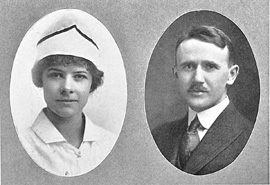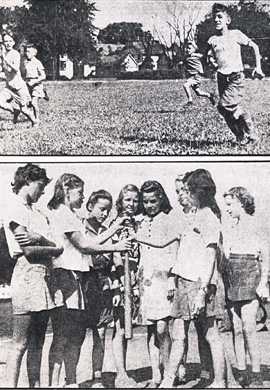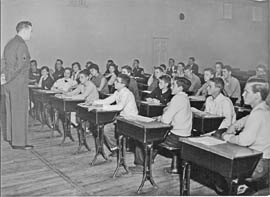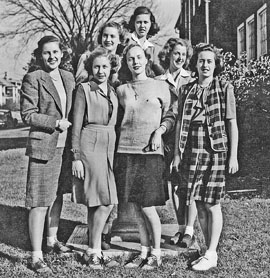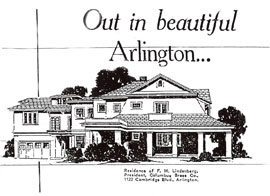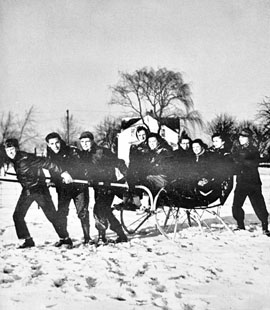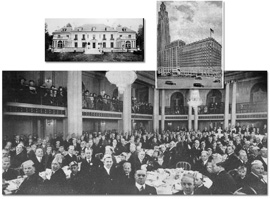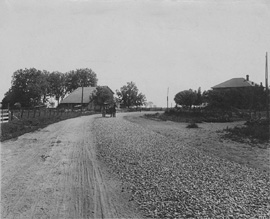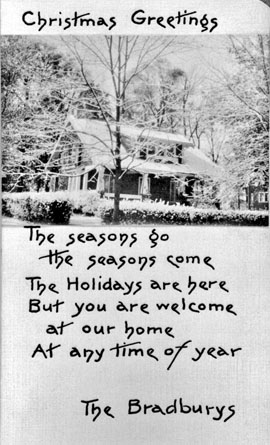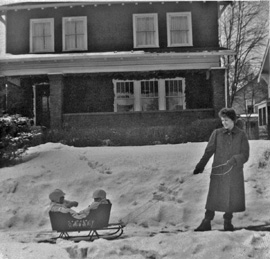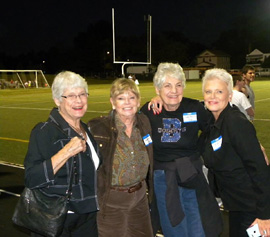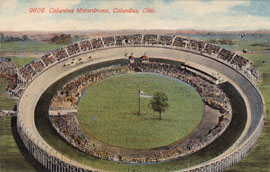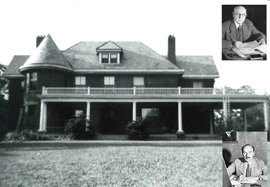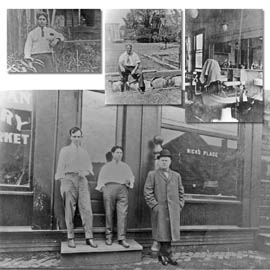In 1924, Dr. Clayton Smith (pictured at the right) was a member of the Faculty of Medicine at Ohio State University and was a professor of Physiological Chemistry. He was also the school physician for Grandview Heights High School. Miss Marie McElwee, pictured along side Dr. Smith, was the school nurse. A graduate of White Cross Hospital, Miss McElwee performed various tests on the students' eyes, ears, noses and throats, gave physical examinations and made house calls on students who were ill. Dr. Smith prescribed on the cases of a more serious nature. Miss McElwee was a member of the staff of Grandview Heights High School, while Dr. Smith was the acting physician who aided Miss McElwee in her work and gave his services free of charge. Their efforts were considered "invaluable and most efficient in every detail" according to the 1924 Year Book of the Grandview Heights High School.
Field Day for the two kids playgrounds in Grandview Heights was held on July 16, 1942. Under the supervision of the Grandview school system, the West play ground, located on Oakland Avenue, north of First Avenue, held the playoffs with the winners to be celebrated at "Parents Night" in the High School stadium. In a close finish of the 40-yard dash for boys 8-10 years old are (left to right) Stanton Jones, Emerson Shell, Tommy Wheeler and Angelo Napolitano. In the second picture trying for first bat in the girls' softball game are Barbara Peters, from the East playground, and Jean Jones from the West, with Sue Southland, Bonnie Glover, Patty Behmer, Marlene Neher, Joan Utley and Janet Cochran looking on. The winning ball team received a watermelon; other winners received ice cream bars. The special "Parents Night" celebration was held the following night as badges were awarded to the final winners.
This undated photograph is from a collection of memorabilia given to the Historical Society, taken from the Grandview Heights High School office. From the style of clothing it appears to date from the 1950s. It shows students listening intently to military recruiters in the large study hall originally present on the second floor of the high school. An Army sergeant is addressing the students while a Marine recruiter and an Air Force Staff Sergeant sit in the background. During this era the study hall was a mainstay of the high school schedule, and was a hub of activity both during and after school (for example, it was decorated for homecoming and football games.) Student "study hall checkers" monitored attendance. Scheduling of study halls has declined due to the current emphasis on students enhancing their college applications with more rigorous academic schedules and extracurricular activities. This large high school study hall has since been partitioned into several classrooms.
These Grandview Heights High School seniors, photographed after volunteering to process gas-ration booklets during World War I, were featured in the Sept. 19, 1944, edition of The Columbus Dispatch. They are (front row, from left) Peggy Gammill, Shirley Close, Angela McGrath, Pat Donovan, (back row) Shirley Ann Arthur, Judy Cash and Ann Devlin. Unbeknownst to these students, the picture and their home addresses also were published in the Dispatch's service edition, which was mailed to combat troops from Franklin County. All the young women received a deluge of letters from soldiers, sailors and Marines from all over the world. Reportedly, none of the letters contained marriage proposals. However, Cash received the official title of "Dream Girl of the 163rd Company," a company of seamen from the Great Lakes Naval Training Center in Illinois.
Note from Jackie Cherry: Another piece of history pertaining to this particular photo, is that it noted that the girls had been processing gasoline ration stamps. During the war my mother worked for the ODT (Office of Defense Transportation) whose job was to oversee gasoline rationing. After the gas coupons were processed by these high school girls, they were turned in to the ODT office for destruction. Every once
in a while, everyone in my mom's office met for a picnic at a shelter house along the Scioto River where they socialized, drank beer and burned the used stamps in a big bonfire so that they could not be used again.
macadamized-road
Six motorcycle patrolmen from the Columbus area pose with their Harley Davidson service bikes. Five are from the Franklin County Sheriff's office, and one is a Grandview Heights patrolman. Robert R. "Rancho" Livingston is second from the right, and his Harley is the far right one. Livingston was only 59 years old when he died in Mt. Carmel hospital of kidney failure in 1958. He had been with the Grandview Police Department since 1937, and was the chief of police for 14 years. Livingston came to Grandview at the age of seven and graduated from Grandview High School (where he was given the nickname "Rancho") in 1920. When Chief Livingston sought work with the Grandview Police Department in 1937, after serving in the military, the only vacancy was in the Fire Department, and he worked there for a short time before he transferred into the Police Department. He and his wife Ella purchased their home at 1286 Wyandotte Road, next door to his parents' home at First and Wyandotte. He was well known by the citizens of Grandview and was not always in uniform, often recognizable for his trademark white Stetson hat. His grandfather founded the Livingston Seed Company, which was one of the first and most prolific tomato seed hybrid providers in the country. Founded as A.W. Livingston's Sons by Alexander Livingston in 1850, they branched out to Iowa, with his son Josiah (Robert's father) taking the helm of the Iowa operation. In 1898, it was renamed Livingston Seed Co. and Josiah moved back to Ohio to raise his family in Grandview.
Early fire emergency responses in Grandview and Marble Cliff were hampered in many ways: volunteers, often with inadequate training, comprised the fire personnel needed to fight a fire; unpaved roads that were necessary to reach the site were often muddy and/or filled with ruts; and equipment and essential resources were often insufficient.
This photo shows ruins of the Dwyer House (built in 1915) at 1198 Lincoln Road. The circumstances surrounding this particular fire (circa 1920s) are not known but early Grandview Heights and Marble Cliff experienced a number of fires that completely destroyed homes and businesses. The extensive damage of many of these early catastrophic fires was due, in part, to a reliance on volunteers, unpaved roads that when muddy were difficult to navigate, and inadequate equipment or hydrant pressure.
Prior to the purchase of the City's first fire truck in 1924, a hose cart (inset), stored in the Henterscheid Grocery building, was hauled by horse or manpower to the location of the fire. In one early episode the team arrived at the scene of a fire only to discover that their new hoses were threaded in a reverse sense from those of the hydrant and could not be attached. The farmhouse at the scene on the east side of the city burned to the ground.
The Looker family owned this home at 1179 Broadview in Grandview for forty years, beginning in 1950. This 1961 photograph shows the Looker daughter Elaine pulling toddlers in a sled in front of the home, which was featured in the Grandview Heights/Marble Cliff Historical Society Tour of Homes in 2010. Elaine passed away in May of this year.
This 1900 square foot home at 1179 Broadview in Grandview was built in 1918 by William G. Jackson, President and General Manager of Jackson Realty Company of Columbus. Jackson lived on Cambridge Boulevard in Marble Cliff. The new house was probably sold immediately to John O. Gooding, Treasurer of the Jackson Realty Company, who moved here from Summit Street in Columbus. The Goodings were followed in 1923 by Maxwell and Sarah Bode, and then in 1926 by Thomas and Sarah Winters. Winters was an agent for Mutual Insurance Company. The home was purchased by Lawrence and Belva Looker in 1950, and they owned it until 1990. Their daughter Elaine is shown in this 1961 photograph pulling children in a sled in front of the home.
This house is representative of the classic American Foursquare architectural style that was popular from the early 1900s, built in urban and suburban neighborhoods until the early 1930s. The Foursquare gets its name from its from its simple, cubic shape and floor plan, with four large rooms on each of the two floors. Arranging the rooms in quadrants eliminated the need for long hallways and made efficient use of interior space. Simple, symmetrical Foursquare homes were less costly to build than more complicated Victorians, and were often available from catalogues such as Sears Roebuck and Co.
The style most often incorporated many of the interior design features of the Craftsman movement, and the Looker home exemplified those interior features. The name "Craftsman" comes from the title of a popular magazine published by the famous furniture designer, Gustav Stickley, between 1901 and 1916. A true Craftsman house is one that is built according to plans published in Stickley's magazine. But other magazines, pattern books, and mail order house catalogs began to publish plans for houses with Craftsman-like details. Soon the word "Craftsman" came to mean any house that expressed the English Arts and Crafts ideals.
The Grandview Heights/Marble Cliff Historical Society is extremely sad to learn that Jane Harris, a Society Trustee and Board Secretary, passed away January 6th at the age of 82 years young. She is shown in a 2014 photo with Grandview Heights High School graduates Jerri (Williams) Lawrence, Jean (McQuilkin) Carfagna, Harris, and Kathy (McQuilkin) Miller.
This postcard, from the Columbus Public Library collection, was mailed from Columbus to a couple in Greenville, Ohio in January of 1913. The image depicts the Columbus Motordrome, which was built and opened in July of 1912, by the Columbus Motordrome Company. An article in the 1912 Motor World magazine contained an entry that the Columbus Motordrome Co. was established in April, 1912, with $20,000 capital, by William Snyder, George Baughem, Philip Vogel, and others, after they were approached by famous Chicago bicyclist and racetrack architect Jack Prince.
According to an article titled Pioneers of American Motorcycle Racing by Daniel K. Statnekov, "Prince's motordrome designs were mostly 'seat-of-the-pants,' an expansion of his earlier sketches for bicycle velodromes, rather than formal construction drawings. The dapper Englishman, wearing his trademark Derby hat, would walk around the site, driving stakes into the ground to mark the layout for the new track. In a grand manner, the board track impresario would hire hundreds of carpenters, and schedule railroad car deliveries of millions of board feet of lumber and tons of steel spikes."
The Columbus Motordrome was built entirely of wood in just a few months on the site of the Arlington Gun Club, near Fifth and Cambridge, and could hold up to 5,000 fans of high speed motorcycle racing in grandstand seats. The enclosed green space, accessible by a tunnel under the track, could accommodate up to 1400 automobiles, or reportedly up to 100,000 fans. Motorcycles could reach speeds of over 90mph on these short (1/4-1/3 mile) banked tracks. The Arlington track closed in 1913 after a fiery motordrome crash in Cincinnati killed a racer and 9 spectators, and injured 35 more, on a similar 30 degree banked track. The accident caused these short-track facilities to be referred to as "murderdromes" because of the number of fatalities across the country, and most were closed over the following several years. Subsequent tracks were longer, and included advanced safety innovations.
The Grandview Heights/Marble Cliff Historical Society and the ThisWeek News began a partnership to publish weekly Moment in Time features in March of 2004. This is a reprint of the first feature story and photograph published.
Mr. Julius F. Stone was an influential Columbus industrialist and entrepreneur who lived in Grandview Heights. His home at 1065 Westwood, which he and his family lived in until the mid-1940s, was razed to develop the current Stonegate Village homes at Westwood and Goodall.
Mr. Stone (upper right) was the owner of Ohio Buggy Works and the Seagrave Co., turn of the century makers of Seagrave fire equipment. Mr. Stone was a trustee of The Ohio State University and President of the OSU Research Foundation. He donated quite a sum of money to the University, endowing a fellowship in Biophysical research and purchasing the first OSU cyclotron.
In 1925 he donated Gibralter Island in Lake Erie near Put-In-Bay to OSU to establish what would become the Franz Theodore Stone Lab, in honor of his father. He was very active in conservation issues, and organized the first Colorado River expedition for sport in 1909. He was inducted into the Ohio Department of Natural Resources Hall of Fame in 1967.
His Harvard educated son Julius Stone, Jr. (lower right) is credited with saving Key West, Florida from total collapse in 1935 and reestablishing it as a mecca of tourism. Another of Julius Stone's sons, George was Commander of the Ohio Wing of the Civil Air Patrol and was the pilot of the first plane to land at Don Scott Field in 1942.
Nicholas Botti was born in Rutino, Italy in 1887 and arrived in Columbus, Ohio when he was 16. He was taken in by the Joe Adorno family, who owned and operated a grocery store on Goodale in Flytown, which was the "melting pot" area of immigrants near Goodall Park in downtown Columbus.
He initially worked in his sponsor family's grocery store, delivering beer, wine, and whiskey by horse-drawn wagon to the construction crews working to build the Griggs Dam on the Scioto River. He later spent time working in the Carmen Spaghetti factory on Goodale Avenue, and finally settled on becoming a barber.
His first barbershop was located at 437 West Goodale and was known as Nick's Place (shown in the photo above, with Botti in the center on the step.) He relocated his family to Grandview Heights and opened The Village Barbershop at 1668 West First Avenue in 1920, just east of what is currently the Seville condominiums and across the street from the Library.
The photo on the upper right shows the interior of the shop which occupied the east side of his building. The west side of his building was leased to various other tenants. Nick Botti became a master gardener and maintained a garden to the rear of the barbershop (upper left and middle). He was especially renowned for the quality of his strawberries and grapes. Nick Botti died in 1974 at the age of 87.
